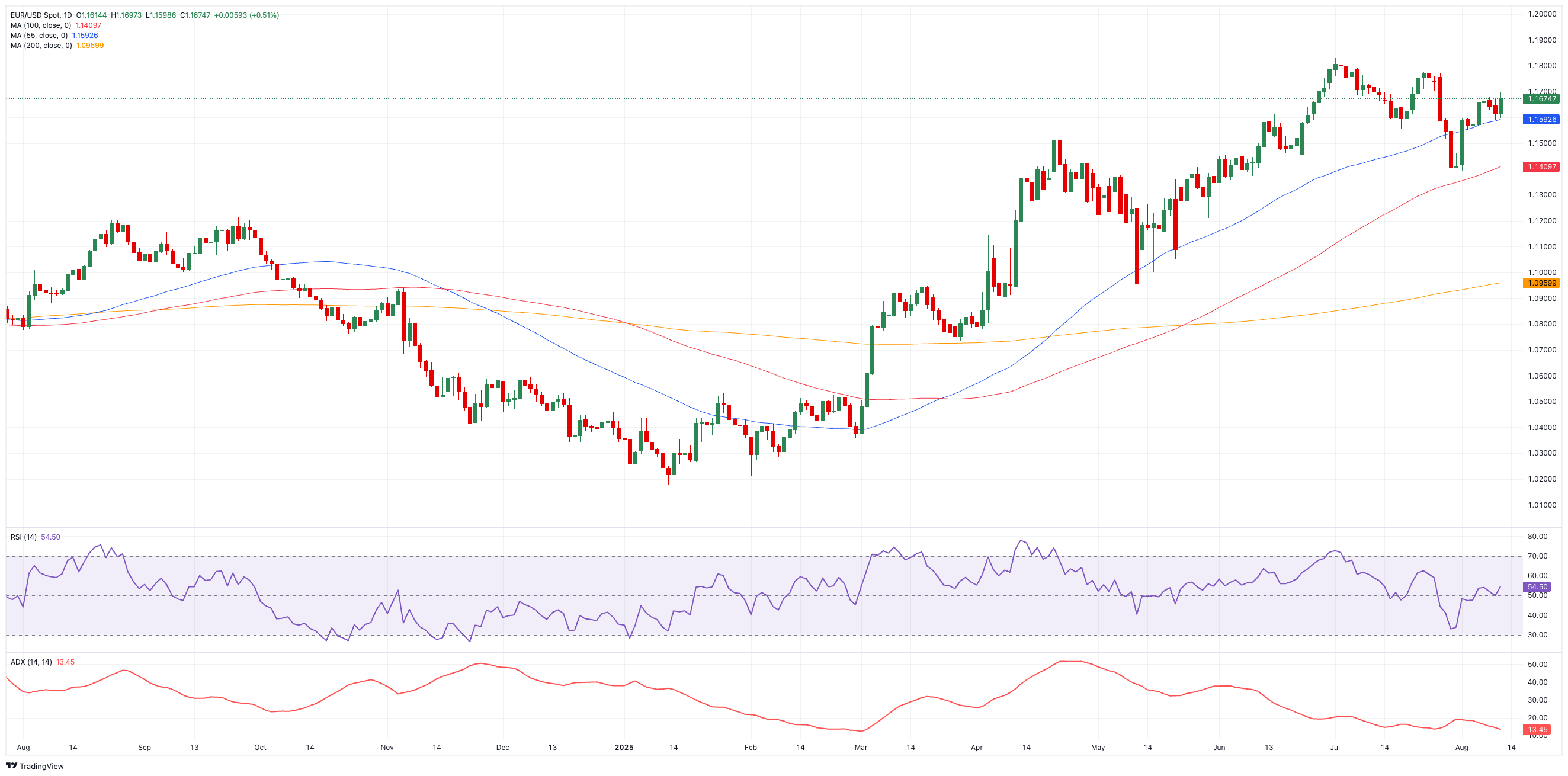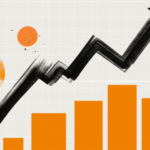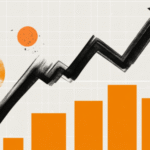
- EUR/USD regained balance and came closer to the 1.1700 barrier on Tuesday.
- The US Dollar traded with marked losses following mixed results from US CPI.
- President Trump extended the US-China trade truce for an extra 90 days.
The Euro (EUR) shook off its sluggish start to the week on Tuesday, with EUR/USD powering higher to multi-day peaks, coming within touching distance of the key 1.1700 mark.
The rally was mirrored by a sharp pullback in the US Dollar (USD), which saw its recent two-day winning streak cut short after July’s US inflation data delivered a mixed picture. With markets still pricing in two potential Federal Reserve (Fed) rate cuts—likely in September and December—the US Dollar Index (DXY) slid steeply, testing two-week lows around the 98.00 zone.
Progress on the trade front lifted spirits
The US and China agreed to extend their trade truce for another 90 days on Monday, narrowly avoiding a fresh round of tariff hikes that had been due to take effect within hours.
Indeed, President Trump signed an executive order on Monday pushing the pause through to November 10, with Beijing quickly confirming it would follow suit. Under the extension, US tariffs on Chinese imports will stay at 30%, while China will maintain its 10% levy on American goods.
The news reinforces the recently signed US–EU accord—cutting most European export tariffs to 15% from a previously threatened 30%. Aerospace, semiconductor, and agricultural goods avoided the new duties, but steel and aluminium remain taxed at 50%. In return, Europe pledged to buy $750 billion worth of US energy, boost defence orders, and channel more than $600 billion into American investments.
Scepticism, however, was swift: German Chancellor Friedrich Merz warned the deal would squeeze an already fragile manufacturing sector, while French President Emmanuel Macron called it a “dark day” for the Continent.
Central banks: Cautious stance
The Fed kept policy unchanged at its latest meeting, with Chair Jerome Powell striking a guarded tone despite dissent from Governors Waller and Bowman.
In Frankfurt, ECB President Christine Lagarde described growth as “solid, if a little better”, but the money markets have already pushed expectations for a first rate cut to spring 2026.
Speculators lighten Euro exposure
Speculators cut net long positions to a five-week low near 116K contracts, while commercial players also trimmed net shorts to around 163.5K contracts, marking multi-week lows. Open interest fell to a four-week low of about 828.3K contracts, all according to the Commodity Futures Trading Commission (CFTC) report to August 5.
Levels to watch
Resistance stands at the weekly high of 1.1788 (July 24), ahead of the 2025 ceiling at 1.1830 (July 1). Further up comes the September 2021 peak at 1.1909 (September 3), just ahead of the psychological 1.2000 mark.
On the other hand, support begins at the August low of 1.1391 (August 1), underpinned by the interim 100-day Simple Moving Average (SMA), and prior to the weekly floor at 1.1210 (May 29).
In addition, momentum signals are mixed: the Relative Strength Index (RSI) has climbed to nearly 55, opening the door to extra upside impulse in the short term. However, the Average Directional Index (ADX) around 15 still suggests the trend need more juice.
EUR/USD daily chart

Outlook: Consolidation seems to be the name of the game
EUR/USD is likely to remain sidelined for now, unless the Fed surprises everybody with a sudden shift of its plans or trade tensions mitigate significantly. Meanwhile, the dynamics surrounding the Greenback should continue to dictate the direction of price movements.
Inflation FAQs
Inflation measures the rise in the price of a representative basket of goods and services. Headline inflation is usually expressed as a percentage change on a month-on-month (MoM) and year-on-year (YoY) basis. Core inflation excludes more volatile elements such as food and fuel which can fluctuate because of geopolitical and seasonal factors. Core inflation is the figure economists focus on and is the level targeted by central banks, which are mandated to keep inflation at a manageable level, usually around 2%.
The Consumer Price Index (CPI) measures the change in prices of a basket of goods and services over a period of time. It is usually expressed as a percentage change on a month-on-month (MoM) and year-on-year (YoY) basis. Core CPI is the figure targeted by central banks as it excludes volatile food and fuel inputs. When Core CPI rises above 2% it usually results in higher interest rates and vice versa when it falls below 2%. Since higher interest rates are positive for a currency, higher inflation usually results in a stronger currency. The opposite is true when inflation falls.
Although it may seem counter-intuitive, high inflation in a country pushes up the value of its currency and vice versa for lower inflation. This is because the central bank will normally raise interest rates to combat the higher inflation, which attract more global capital inflows from investors looking for a lucrative place to park their money.
Formerly, Gold was the asset investors turned to in times of high inflation because it preserved its value, and whilst investors will often still buy Gold for its safe-haven properties in times of extreme market turmoil, this is not the case most of the time. This is because when inflation is high, central banks will put up interest rates to combat it. Higher interest rates are negative for Gold because they increase the opportunity-cost of holding Gold vis-a-vis an interest-bearing asset or placing the money in a cash deposit account. On the flipside, lower inflation tends to be positive for Gold as it brings interest rates down, making the bright metal a more viable investment alternative.
Information on these pages contains forward-looking statements that involve risks and uncertainties. Markets and instruments profiled on this page are for informational purposes only and should not in any way come across as a recommendation to buy or sell in these assets. You should do your own thorough research before making any investment decisions. FXStreet does not in any way guarantee that this information is free from mistakes, errors, or material misstatements. It also does not guarantee that this information is of a timely nature. Investing in Open Markets involves a great deal of risk, including the loss of all or a portion of your investment, as well as emotional distress. All risks, losses and costs associated with investing, including total loss of principal, are your responsibility. The views and opinions expressed in this article are those of the authors and do not necessarily reflect the official policy or position of FXStreet nor its advertisers. The author will not be held responsible for information that is found at the end of links posted on this page.
If not otherwise explicitly mentioned in the body of the article, at the time of writing, the author has no position in any stock mentioned in this article and no business relationship with any company mentioned. The author has not received compensation for writing this article, other than from FXStreet.
FXStreet and the author do not provide personalized recommendations. The author makes no representations as to the accuracy, completeness, or suitability of this information. FXStreet and the author will not be liable for any errors, omissions or any losses, injuries or damages arising from this information and its display or use. Errors and omissions excepted.
The author and FXStreet are not registered investment advisors and nothing in this article is intended to be investment advice.








